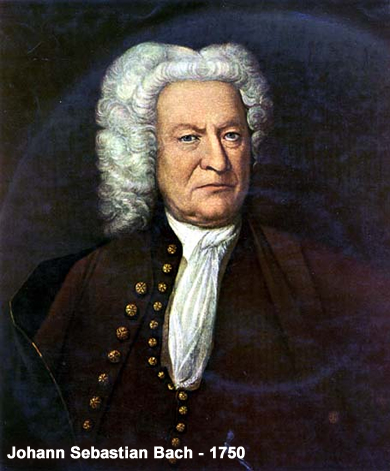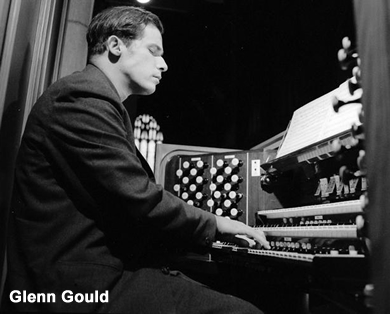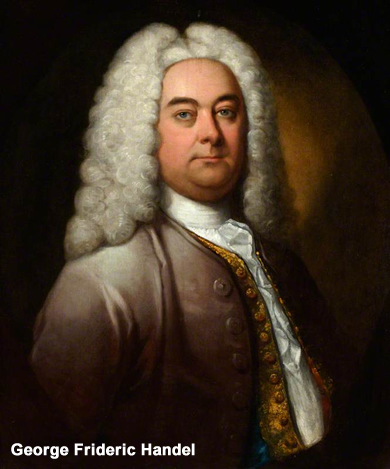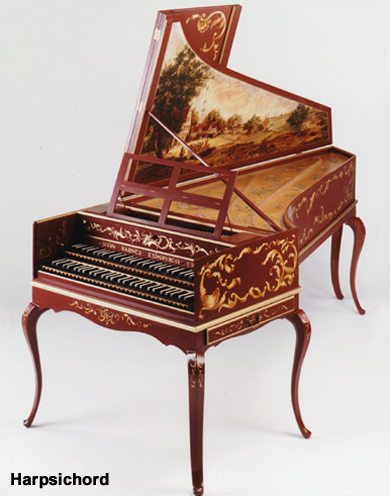 Johann Sebastian Bach (1685-1750)
Johann Sebastian Bach (1685-1750)
The Art Of The Fugue, BWV 1080
George Frideric Handel (1685-1759)
Glenn Gould – Organ/Harpsichord
CBS Masterworks Portrait
ONE-SENTENCE REVIEW:
More like the “Fart” Of The Fugue! (No, actually this is quite good.)
ORIGINAL LINER NOTES (uncredited):
Bach began composing his Art Of The Fugue in 1748 or 1749 and continued to work on it in 1759, the last year of his life. He had finished three-quarters of Fugue No. 15 when a severe eye disease obliged him to leave off work on his artistic last will and testament and undergo an operation.
 A combination of primitive medical techniques and a blundering doctor proved fatal – within six months of this operation Bach was dead.
A combination of primitive medical techniques and a blundering doctor proved fatal – within six months of this operation Bach was dead.
He spent his last days in a darkened room, alone with the God he had served and glorified all his life.
When he felt death close upon him, he sent for his son-in-law, the musician Altnikol, and dictated to him not the conclusion of the great B-A-C-H fugue but a chorale fantasia on melody “When We Are In Deepest Need,” telling Altnikol to entitle it “I Draw Near Unto Thy Throne.” In the manuscript we can see all the pauses that the “sick man had to permit himself.”
Albert Schweitzer narrates: “The drying ink becomes more watery from day to day – the notes written in the twilight, with the windows closely curtained, can hardly be deciphered.”
This last composition from Bach’s pen was included in the first edition of the Art Of The Fugue, not because it belongs with that work but as an apologetic compensation to the purchaser for the completeness of the work itself. How incomplete the Art Of The Fugue is we do not know.
The mammoth Fugue No. 15 may have been the final one of the series, or Bach may have planned to follow it with a still more grandiose quadruple fugue. The latter contention was Sir Donald Tovey’s and Tovey actually complete the fifteenth fugue and composed, as the sixteenth, a totally invertible fugue with four subjects, to prove that such a feat was possible and that Bach had something of a the sort in mind.
Most performances of the Art Of The Fugue, however, are content to break off where Bach himself broke off, for there is something awesome about this sudden silence just at the point when Bach introduced the letters of his own name for the first time into one of his works.
 The most vexing problem, of course, is whether or not Bach intended the Art Of The Fugue to be played at all. He does not once in the entire work indicate a tempo or a dynamic marking. He does not indicate what instrument or instruments should play the work. He writes each of the voices on a separate staff (in so-called “open score”), which is very helpful for the student but anything but helpful for the keyboard player.
The most vexing problem, of course, is whether or not Bach intended the Art Of The Fugue to be played at all. He does not once in the entire work indicate a tempo or a dynamic marking. He does not indicate what instrument or instruments should play the work. He writes each of the voices on a separate staff (in so-called “open score”), which is very helpful for the student but anything but helpful for the keyboard player.
This leaves the field open to the arranger, and arrangers have eagerly rushed in. There are multiple versions for orchestra, for string quartet, for two pianos, for organ, for piano solo. Only the musical pedant can find these various realizations a source of annoyances – the genuine music lover will make his own choice or choices and take pleasure in the process.
Whatever choice he makes, the Art Of The Fugue remains massively and imperturbably itself. For though it is devoid neither of humanity nor emotion, the human and the emotional are not its real concern. Like the figure on Keats’ urn, it has passed out of time and accident, and wears the changeless beauty of pure thought.
 George Frideric Handel wrote a great deal of music for the harpsichord. Yet, the publication in 1720, of his first book of Suites de pieces de clavecin was still an extraordinary event. It was the first authorized publication of any of his instrumental works, and it was to remain the only collection of harpsichord suites he issued under his own auspices.
George Frideric Handel wrote a great deal of music for the harpsichord. Yet, the publication in 1720, of his first book of Suites de pieces de clavecin was still an extraordinary event. It was the first authorized publication of any of his instrumental works, and it was to remain the only collection of harpsichord suites he issued under his own auspices.
The Suites are rather unorthodox in form and do not follow the generally established dance sequence of the eighteenth century instrumental suite. Each of the four recorded here follows a difference pattern, and they are best described individually.
No. 1 in A Major – The Prelude for this suite consists primarily of a sequence of chords that invite the performer to invent his own embellishments. Glenn Gould contributed an intricate personal statement composed expressly for this recording. This brilliant Prelude, combining arpeggios and scales, is followed by three dances – Allemande, Courante, and Gigue – that are in Italian style.
No. 2 in F Major – This is not really a suite at all but a sonata de chiesa in the Italian style, of the type often composed for violin and continuo. The movements follow the common pattern: Adagio, Allegro, Adagio, Allegro.
 No. 3 in D Minor – Like Bach whose Clavierubung Book II appeared fifteen years later, Handel here is writing orchestral music for harpsichord. Unlike Bach, Handel later reused some of the pieces in the Concerti Grossi of Op. 3. The first two movements, Prelude and Allegro, are actually a prelude and fugue. Italianate dances, an Allemande and a Courante, are then followed by an Air and Variations and a concluding Presto.
No. 3 in D Minor – Like Bach whose Clavierubung Book II appeared fifteen years later, Handel here is writing orchestral music for harpsichord. Unlike Bach, Handel later reused some of the pieces in the Concerti Grossi of Op. 3. The first two movements, Prelude and Allegro, are actually a prelude and fugue. Italianate dances, an Allemande and a Courante, are then followed by an Air and Variations and a concluding Presto.
No. 4 in E Minor – The opening Allegro is a fugue, in the style of Italian violin music. The following movements, Allemande, Courante, Sarabande and Gigue, comprise the most, orthodox suite sequence in the entire collection.
While Handel’s harpsichord works may not be the most important segment of his production, the best of them are fully worthy of his genius. Their values in relation to Handel’s better known music are pointed out by the eminent musicologist Paul Henry Lang: “A number of these compositions serve as proving grounds for his dramatic works in them appear certain basic ideas and models that were to follow Handel throughout his career.”
And of all his works, it is probably the first book of suites, along with the Organ Concertos, that provides us with the best picture of Handel as performer-composer.
TRACK LISTING:
- 1-9: Bach – The Art Of The Fugue, BWV 1080
- 10-13: Handel – Harpsichord Suite No. 1 in A Major
- 14-17: Handel – Harpsichord Suite No 2. in F Major
- 18-22: Handel – Harpsichord Suite No. 3 in D Minor
- 23-27: Handel – Harpsichord Suite No. 4 in E Minor
FINAL THOUGHT:
Listening to solo organ is not the most pleasant experience (even Bach), but I can imagine how thrilling it would have been to be sitting in a symphonic hall or grand church and listening to Glenn Gould play the Art Of The Fugue. I’m fairly certain that wouldn’t suck.
 Emily Sachs – President – Manka Music Group (A division of Manka Bros. Studios – The World’s Largest Media Company)
Emily Sachs – President – Manka Music Group (A division of Manka Bros. Studios – The World’s Largest Media Company)



Probably sacrilege, but I actually like the Handel much more than the Bach on this CD. The organ is a bit much to take with Bach. Too much movement – not enough sustain. Which is what I like in organ music.
Agreed. I wish I would have said it like that in my review.